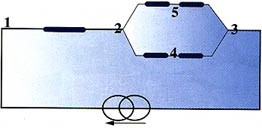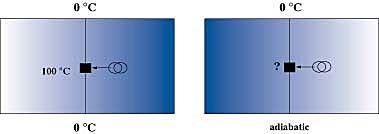|
introduction
dark light, deafening silence, cruel kindness, living dead, fuzzy logic, honest politics. the adjectives seem to contradict the substantives; such a figure of speech is called an oxymoron. it will be argued within this article that 'thermal resistance' is also a serious candidate for this category, at least if the concept is being applied without realizing the differences between thermal and electrical resistances, rather the rule than the exception in practice.
the notion of 'thermal resistance' is deeply rooted in the vocabulary of the thermal designer. every textbook treats the fundamental analogy between electrical and thermal resistance, and all the thermal data found in the component data sheets is presented in the form of either thermal resistance from junction to case (rth j-c) or junction-to-ambient (rth j-a). usually, these resistances are defined somewhere in the introduction. of course, it is possible to define everything, and to call it what you want, as long as the expressions at both sides of the equal sign have the same dimensions.
there is no law that the definition should make sense from a physical point of view. nobody objects to the use of the phrase 'dark light' in a poem. and here we meet the problem. most people are of the opinion that the definition should have a physical significance, on the grounds that an electrical resistance certainly has a physical meaning (the voltage between two points divided by the current from one point to the other), and smart professors told them that electrical and thermal differential equations are identical.
electrical and thermal resistances
unfortunately, the conclusion 'electrical and thermal resistance are analogous' is wrong, while the proposition 'electrical and thermal differential equations are analogous' is right. why? mother nature has to be blamed. somehow, at the beginning of time (or maybe even before that), the building stones of matter and life were arranged in such a way that what an electrical engineer calls 'insulation' is about 20 orders of magnitude away from what he calls 'conduction', while, in thermal terms, the difference between 'insulation' and 'conduction' is about 3 orders of magnitude. to highlight the distinction, the thermal difference between insulation and conduction is about the difference in conduction between high-doped and low-doped silicon in electrical terms (ref. 1). maybe better so; just imagine how the world would look, if it was the other way around.
this mere fact has a very important consequence which, regrettably, is often not mentioned by the same professors who usually focus only on the mere elegance of the symmetry in the differential equations:
in many cases of practical importance, there is no such thing as purely one-dimensional heat conduction in the thermal world, in contrast to the electrical world.
let us recall the definition of electrical resistance:
"the voltage difference between two points divided by the current that flows between them is the electrical resistance."
this definition is so simple because it is usually applied to single wires, tracks or blocks in which all the streamlines leaving the first node end at the second node. now, let us try to define thermal resistance in the same sense. it turns out that the definition should be very carefully formulated, to arrive at a precise and unambiguous meaning. we propose the definition as provided in ref. 2.
"the temperature difference between isothermal surfaces divided by the heat that flows between them is the thermal resistance of the materials enclosed between the two isothermal surfaces and the heat flux tube originating and ending on the boundaries of these two isothermal surfaces."
many of the apparent paradoxes presented in the literature on this subject are attributed to the application and measurement of thermal resistances to situations in which their physical meaning, according to the above definition, is not well defined. for example, take the thermal resistance of some package, from junction to case. in practical circumstances, this resistance cannot be an invariant quantity designated by one number, because the orientation of internal conduction heat flow paths changes in response to changes in the thermal environment. in other words, this thermal resistance is no longer a function of the package parameters, but becomes dependent on the boundary conditions. in terms of the definition, it means simply that the location of the heat flux tube is not constant. part of the heat leaving the junction and entering the case might take a completely different path, see the second example below.
the jedec standard
the recently-issued jedec standard ('95) also recognizes the fact that the temperature difference between two points divided by the power dissipated is not a thermal resistance. the standard introduces a new quantity, viz. the junction-to-top-center-of-package thermal characterization parameter, denoted by ψjc, defined as the temperature difference between junction and top center of the package divided by the power. the top-to-ambient thermal characterization parameter is denoted ψta. although the junction-to-ambient thermal resistance is the sum of the two parameters ψjc and ψta neither of these components individually is a thermal resistance:
"the thermal characterization parameters, ψjc and ψta, have the units of k/w, but are mathematical constructs rather than thermal resistances because not all of the heating power flows through the exposed case surfaces."
to probe this issue further, consider the following example. we split an electrical wire, and measure the voltage across points 1 and 4 according to the following sketched scheme:

now, we ask an electrical engineer what the resistance is between these points. probably he or she will cordially suggest a consultation with a shrink, and yet, this happens frequently in the thermal world.
for example, call node 1 'junction', node 2 'die attach', node 3 'ambient', node 4 'central-case', and node 5 'outer-case'. suppose the temperature difference between 'central-case' and 'junction' is measured, and divided by some power (usually the total dissipation). it is common practice to call the result the 'junction-to-case thermal resistance'. obviously, there is no analogy here between electrical and thermal resistance, for the simple reason that an electrical resistance does not exist between the two points mentioned.
let us take another example to illustrate the failure of the concept of thermal resistance. consider an infinite strip of plastic with adiabatic sides, with a width to thickness ratio of 4, and an electrical wire running through the center which can be heated. suppose we impose a constant temperature of 0 °c at both remaining sides ('bottom' and 'top'). let the dissipation be such that the temperature of the wire is 100 °c. if one is asked to draw the equivalent resistor network, it will obviously look like the figure on the left:

it turns out that this is a physically correct formulation, because it is a consequence of the formal definition cited before. let us replace the constant temperature boundary condition at the bottom with an adiabatic boundary condition (the previous figure on the right). the question is: what will be the new temperature? based on the network representation, the answer follows immediately: 200 °c, because obviously the heat flux through the bottom resistor is zero, and the effective heat transfer area halves. what is the real answer? about 120 °c! the first answer is not even close. the reason is, as noted before, that the heat transfer paths change completely as a result of the change in boundary conditions, and, consequentially, the network derived for the first situation cannot be used for the second one.

figure 1. iso-flux lines for a 2d isotropic bar.
left figure: top and bottom constant temperature, side adiabatic. right figure: top constant temperature, bottom and side adiabatic.
the problem
the problem comes down to the following:
in some cases, thermal resistances could be derived that make sense. in closer examination, the chances are high that the thermal behavior can be described by approximately 1d heat conduction. in other cases (like θj-c), the definition clearly violates the physics, at least, if one is of the opinion that the term 'resistance' should resemble the meaning in the electrical field. the resulting value, though, might have practical relevance. for many plastic packages, a network can be derived for a certain application. the network may consist of two resistances (for example, junction-to-board and junction-to-case), or more. using the same network for other boundary conditions could result in large errors, as demonstrated in many papers published by the delphi consortium (ref. 3).
to overcome this problem, the values of the network resistors can be fitted by optimization techniques to accommodate many different boundary conditions. however, in doing so, the resulting 'thermal resistances' lose their physical meaning completely, as argued in ref. 4, and one may wonder if the term 'thermal resistance' should be kept, on account of the persistence of the analogy in the minds of most scientists and designers for some time to come.
conclusion
in summary, the conclusion that should be drawn from the preceding section can be formulated as follows:
in all cases, a thermal resistance can be defined, but in many practical cases, the physical significance of the definition is meaningless, with the exception of those definitions which incorporate the ultimate heat sink (an ambient at uniform temperature) as one of the nodes.
as a consequence, the widespread notion of a universal analogy between electrical and thermal resistances hampers a correct understanding of the physics."
in closing, the author feels strongly that understanding the way in which thermal resistances differ from their electrical counterparts might help the designer in correctly interpreting his or her thermal resistance measurements and calculations.
clemens lasance
clemens lasance, retired in september 2009, was a principal scientist at philips research in eindhoven, the netherlands. he has been on the philips staff since 1969, after he received his physics degree at eindhoventechnical university. from 1984 onwards, his main focus has been thermal management of electronic systems. in 1996, he moved to research, engaged with a long-term research program in this field. he published over 80 conference and journal papers. both in 1995 and 2009 he (as the leading author) received the best paper award at semitherm. he is an editor of electroinc cooling magazine since its launch in 1995 and of microelectronics reliability.
from 2000 to 2002, he led a successful ec-funded ten-partner consortium project called profit resulting in 85 papers and 60 deliverables. he received the semitherm significant contributor award in 2001. he was the general chair of semitherm 2003 and acted as the co-program chair of therminic for nine years. in 2006 he was the recipient of the harvey rosten award for recognition of his pioneering contributions to thermal management issues over the past two decades.
references
1. de mey, "misunderstandings of heat transfer in the electronics engineering community", proce. therminic, 1995, villard de lans, france.
2. rosten and c. lasance, "delphi: the development of libraries of thermal models of electronic components for an integrated design environment", in model generation in electric design, eds. j. berge et al., kluwer, 1995, pp. 63-90.
3. rosten, h., "final report to semitherm xiii on the european-funded project delphi: the development of libraries of thermal models of electronic components for an integrated design environment", proc. semitherm xiii, austin tx, 1997, pp. 73-91.
4. lasance c., "thermal characterization of electronic parts with compact models: interpreation, application, and the need for a paradigm shift", proc. semitherm xiii, austin tx, 1997, pp. 40-48.
|